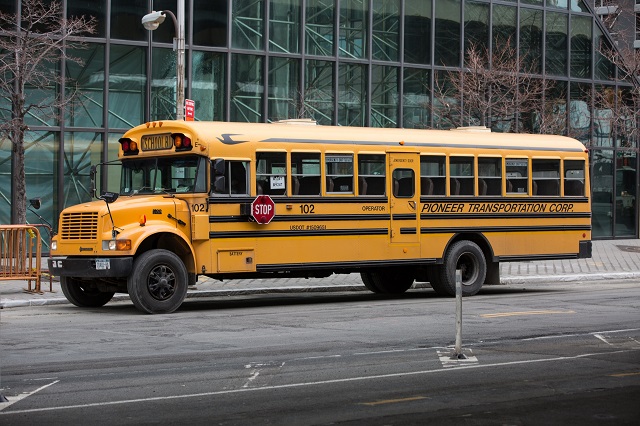
Image: George Hodan, CCO Public Domain via PublicDomainPictures.net
What does a school bus look like? Different people will likely provide different descriptions. Though they may also highlight very specific details like the standard yellow-orange color the great majority of people associate with these vehicles.
The truth is that not every school bus is the same. Some are shorter and others are long. Some may have flat fronts or look like modified passenger vehicles.
There are different classifications based on the vehicle chassis used and passenger count that organize these lumbering giants into eight categories.
This article will highlight these different categories, when they might be used in the transportation setting, and some of the advantages and disadvantages of each.

Image: U.S. Government Accountability Office from Washington, DC, United States, Public domain, via Wikimedia Commons
Importance of Understanding the Classification
It’s important that drivers and administrators understand the classification system used to categorize school buses.
The transport team is responsible for the safety of students while also following federal motor vehicle safety regulations.
Overview of the 8 Types of School Buses
Here is a sampling of the different bus types that are in use throughout school districts today. After this overview, we will break each one down individually.
- Type A – A shorter frame vehicle for shorter trips with a cutaway front section.
- Type B – A shorter frame bus body installed on a front-section conventional chassis with the engine beneath or behind the windshield and the entrance door behind the front wheels.
- Type C – A conventional or traditional style bus with the body installed on a flat-back cowl chassis and the entrance door behind the front wheels.
- Type D – A transit-style bus with the engine beside the driver’s seat or behind the rear wheels and an entrance door ahead of the front wheels.
- Multifunctional Activity Bus – A specialized bus with more cargo room and exempt from traffic control, stop arms, and flashing lights requirements.
- Special Needs Bus – A modified school bus with extra equipment designed to support students with special needs or disabilities.
- School Van – A converted van that is altered to meet school bus safety regulations.
- Allowable Alternate Vehicle – A modified consumer vehicle that meets school bus safety standards but not conspicuity standards for buses.
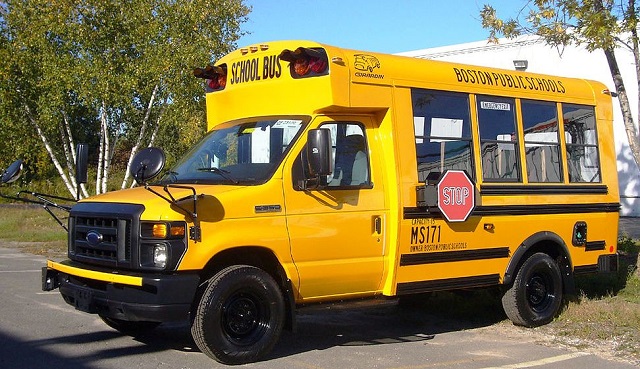
Type A
The Type A school bus is constructed from a cutaway front section. It contains a left driver’s door and has a capacity ranging from 12 to 30 students.
This category of bus is subdivided into A-1 and A-2 models. Type A-1 has a weight rating of 10,000 pounds or less. Type A-2 has a weight rating of 10,000 pounds or more.
The weight rating, called the Gross Vehicle Weight Rating (GVWR), is the maximum allowable weight of the bus including its fuel, passengers, equipment, and driver.
This transport tends to be a shorter body style and is used for shorter trips than a standard-size bus.
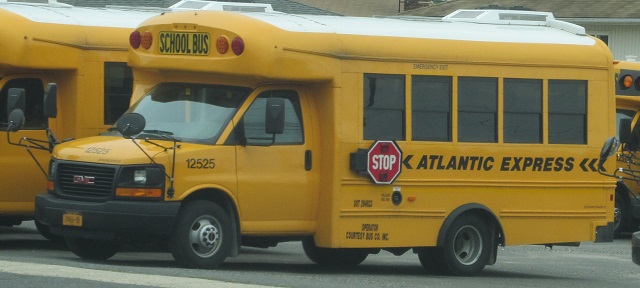
Image Credit: ThoseGuys119 / flickr
Type B
Type B school buses are similar in many ways to the Type A variety. It is a bus body that is built and installed upon a stripped chassis or front-section vehicle chassis.
It is designed to carry 10 or more students and has a GVWR of more than 10,000 pounds. The engine is placed beneath or behind the windshield and the entrance door is located behind the front wheels.
The Type B school bus falls in between Type A and Type C in size. This type of bus is less common on the road today and is designed to meet specific school district needs.
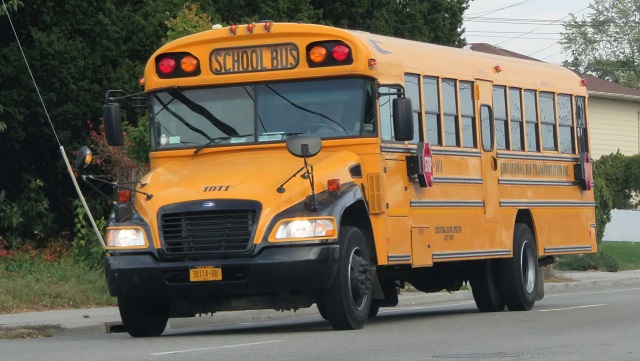
Image Credit: ThoseGuys119 / flickr
Type C
Type C school buses are the traditional or conventional design that comes to mind when most people think of school buses. These are the ones depicted in movies and in use in thousands of school districts across the country.
The body of the bus is a flat-back cowl chassis with a Gross Vehicle Weight Rating of more than 10,000 pounds. Typically, the GVWR falls in the range of 23,500 to 29,500 pounds.
The entire engine lies in front of the windshield and the entrance door is behind the front wheels.
The passenger capacity is generally 54 to 78 students, and this design is the most used for transporting students from school to home.
Having the engine in front of the driver affords some extra protection in the event of a head-on collision. It also puts the engine in an easy spot for maintenance.
This style of bus is good for backroads because it provides a good approach angle and clearance. It gives more interior space for passengers.
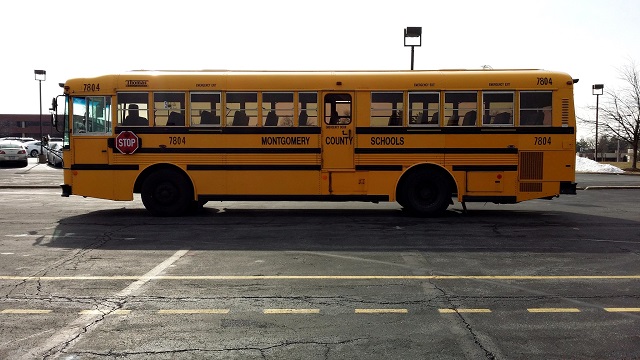
Image Credit: Ben Schumin / flickr
Type D
The Type D school bus consists of a body installed upon a chassis with a GVWR of more than 10,000 pounds. Often the weight rating is between 25,000 and 36,000 pounds.
It is referred to as a “transit-style” bus and resembles buses often used in municipality bus systems. These buses have the engine placed behind the windshield which gives the buses a flat front.
Different designs place the engine in different spots. Rear-engine, or “RE”, models have the engine at the rear of the bus behind the rear wheels.
Forward-engine, or “FE”, models have the engine beside the driver’s seat. Alternatively, some configurations have the engine midship between the front and rear axles.
In this category of bus, the entrance will be located forward of the front wheels. Up to 90 students may be transported in one trip using this style of bus.
The rear-engine design has some significant advantages. It can provide a smoother and quieter ride since the engine is further from the driver. It also affords the driver better visibility.
This style can be more expensive, and the longer wheelbase may make it less agile overall than the standard Type C bus.
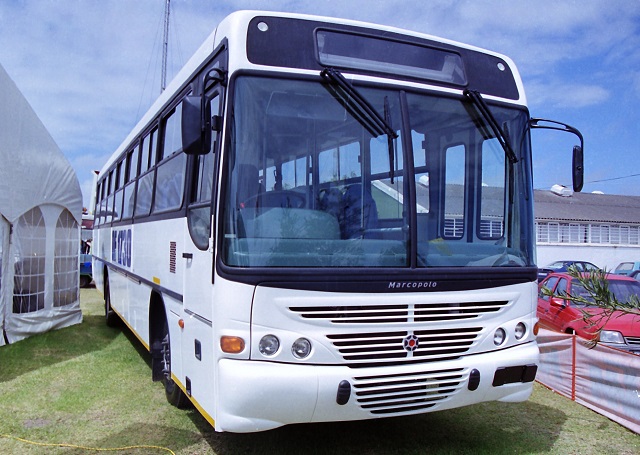
Image Credit: Bob Adams / flickr
Multifunctional Activity Bus
The next type of school bus is a Multifunction School Activity Bus (MFSAB). If a vehicle meets the standards for this classification, it will be labeled by the manufacturer with a sticker identifying it as such.
Multifunction School Activity Buses may be used by a school district to transport students on trips but not between home and school.
These buses require an annual inspection. Drivers are required to have a school bus endorsement to drive them.
While these vehicles will have the same basic shape and body design as standard buses, most states don’t require these vehicles to be the standard school bus yellow-orange color.
They do not need to have stop arms that extend when the vehicle comes to a stop. Nor are they required to have flashing traffic control lights like regular school buses.
These might be used to transport adults or children and their cargo and equipment needed for activities or sports.
Schools are not the only groups that use this type of transport. Many businesses and sightseeing organizations also choose to supplement their fleet with this type of vehicle.
The design meets the same rigorous Federal Motor Vehicle Safety Standards as regular school buses and therefore makes for an attractive and safe option for the transport of people and cargo.
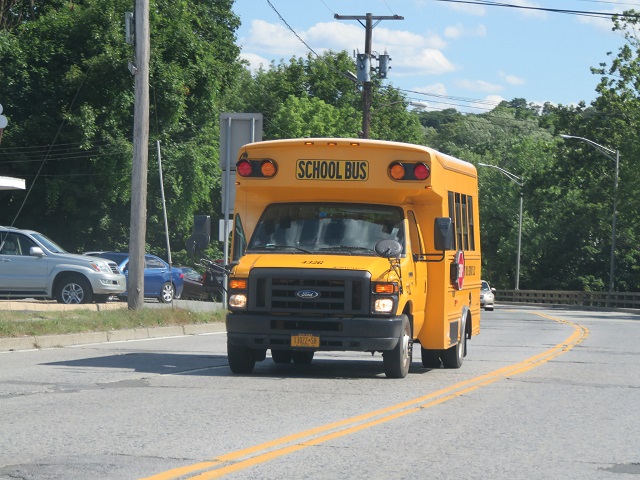
Image Credit: ThoseGuys119 / flickr
Special Needs Bus
Special Needs buses are standard buses with appropriate additional equipment for passengers with specific medical or assistive supports.
For example, children with autism and a tendency toward elopement may have seats equipped with safety harnesses. EZ-ON Zipper Vests can be installed to keep passengers in a comfortable and upright position.
Some buses may come equipped with lift systems to safely load and unload kids with wheelchairs or other assistive mobility technology.
Service animals may also be given special accommodations with this classification of school bus.
It’s important to understand program, school, and state regulations to address the needs of individual passengers. For example, rules may require extra personnel on this type of bus.
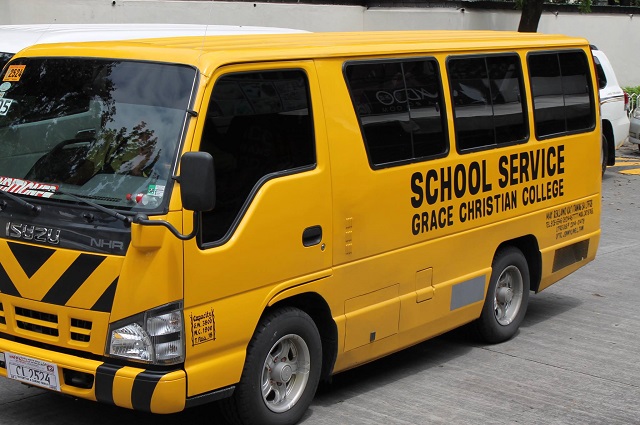
Image Credit: Microtexnano, CC BY-SA 4.0 , via Wikimedia Commons
School Van
School vans are often normal vans that have been converted to meet motor vehicle safety standards for buses.
This may require alterations like cutting off the roof to make the van taller. Or a full roll cage may be welded to the body of the bus to provide greater protection for side impacts or in the event of a crash.
These vehicles may be based on commercially available models like the Ford Transit 350 Wagon or other similar vehicle lines from other manufacturers.
However, these 12-passenger vehicles undergo extensive modification to rise to the appropriate school bus safety standards. Otherwise, they may not be used to transport students between home and school.
The benefit of these vehicles is that they meet all federal safety standards while driving like a standard van.
Allowable Alternate Vehicles
Other vehicles may be used by schools to transport students or cargo. For example, SUV-type vehicles like the Chevrolet Suburban may be converted to meet required safety standards.
However, these vehicles may not meet conspicuity regulations like yellow-orange paint and flashing lights or stop arms.
These vehicles may be used by Head Start transportation or for the transport of students and staff for school activities.
Conclusion
In conclusion, there are a variety of options when it comes to bus designs. School districts across the country choose the options that best fit their needs and unique circumstances.
Summary of the 8 Types of School Buses
- Type A – This is a short-frame vehicle for shorter trips with a cutaway front section and is designed for transporting 10 or more students.
- Type B – This category of bus is slightly larger than Type A and features a body installed on a front-section conventional chassis with the engine beneath or behind the windshield and the entrance door behind the front wheels with the ability to transport more than 10 passengers.
- Type C – Type C is the traditional bus design with a body built on a flat-back cowl chassis and the entrance door behind the front wheels and is used for transporting up to 78 students.
- Type D – This design is a transit-style bus with the engine beside the driver’s seat or behind the rear wheels and an entrance door ahead of the front wheels. Capacity is up to 90 passengers.
- Multifunctional Activity Bus – Activity buses are specialized-use with more cargo room and exempt from traffic control, stop arms, and flashing lights requirements, though meeting all crash-worthiness standards for buses. These are not used for transporting students from home to school.
- Special Needs Bus – This is a modified school bus with extra equipment designed to support students with special needs or disabilities.
- School Van – This category of buses is made up of converted vans that are altered to meet all school bus safety regulations.
- Allowable Alternate Vehicle – This is a classification for all other school and cargo vehicles that are not designed for transporting students from home to school but may be used for other purposes such as activity transportation or Head Start transportation.
Importance of Understanding the Classification
School districts should try to understand the differences between bus categories. The size of the vehicle will play a part in what areas can be used as pick-up and drop-off locations.
Passenger capacity will affect the number of routes that must be run. So, larger buses may reduce the number and cost of vehicles to maintain but may leave kids with longer wait times.
Driver ability may be a factor to consider. Smaller buses may be less intimidating to newer drivers.
Recommendations On Which Type of School Bus is Best for Specific Needs
Type A and B buses are suited for the transport of a smaller number of students and for shorter distances.
Type C buses, the traditional model used nationwide, provide a nice balance of capacity, comfort, and drivability that makes this an all-around attractive option for districts.
Type D buses may be useful in urban environments where a large number of students need to be transported through well-maintained roads to neighborhoods.
Multifunctional activity buses will be used to transport students to academic and sporting events, not to their homes. Special needs buses are specific-use vehicles that can accommodate passengers with special needs or disabilities.
School vans – converted consumer vehicles – are useful for less-experienced drivers. Allowable alternate vehicles may be used for activities or education-related programs like Head Start but not for the regular transportation of students from home to school.
Additional Resources
Here are some helpful additional resources on school buses that provide background on these common conveyances.
Safety Standards Imposed by the Federal Motor Vehicles Department
School buses are the most regulated vehicles on the road. Every state has imposed traffic laws surrounding these vehicles, such as stopping when the stop-arm is extended, to protect children from other motorists.
Vehicle requirements for school buses are overseen by the National Highway Traffic Safety Administration (NHTSA) which falls under the US Department of Transportation.
In addition, individual states enforce stricter requirements, so it’s important to consult with State Departments of Education when operating school buses in different parts of the country.
Why School Bus Designs Remain Unchanged
Since a conference in 1939 where a set of standards was agreed upon, the design of school buses has remained largely unchanged.
There have been incremental changes and updates to provide better safety features. These include wheelchair access, emergency exit windows, and the stop arm design.
However, there have not been huge redesigns in the last 80 years. With a standardized look, they are easily recognizable. While a drastic design change, like a new color, could modernize the look, it might not get the attention of motorists as quickly.
The National Congress on School Transportation meets every 5 years to vote on school bus standards changes. Any alterations to the design must conform to the original minimum requirements decided upon back in 1939.
Contact Information for Expert Advice and Support on Selecting the Right School Bus
When trying to select the right design for school buses in your school district, it’s important to get expert advice.
Colleagues from neighboring districts in the same state may be able to provide good suggestions. The state-level Department of Education can provide additional guidance on acceptable vehicles.
Most school bus manufacturers like Blue Bird or IC Bus can help you find a local dealer that will be in the best position to give advice on local purchasing questions.
References
https://stateaid.nysed.gov/SAMSHelp/SAMS%2017-18%20Help/HTML/School_Bus_Types.docx
https://americanbussales.net/seven-different-school-bus-types
https://www.trackschoolbus.com/types-of-school-buses
http://dmv.vermont.gov/CVO/school-bus/types-of-school-buses
https://www.especialneeds.com/blog/bus-safety-and-transportation-with-special-needs-students
https://www.nationalbus.com/blog/2022/10/07/the-difference-between-type-c-and-type-d-school-buses



